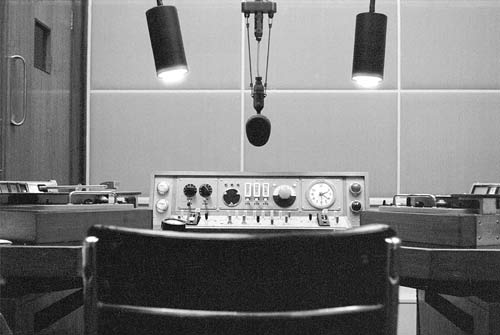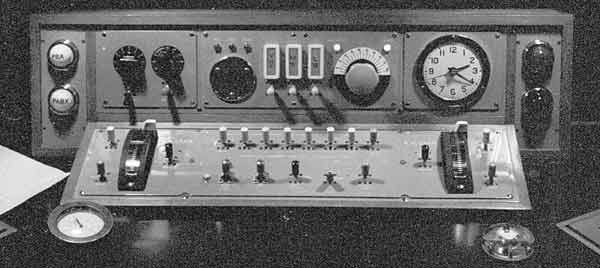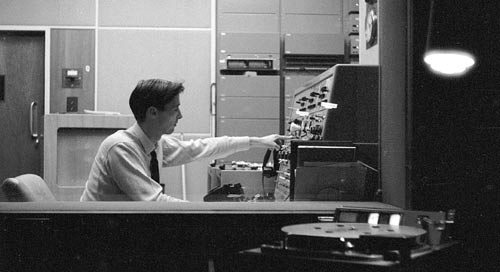

On the left of the vertical panel are two white telephone indicator lamps. The lower one indicated an incoming call on the PABX system and the upper one indicated a call on the direct 'red' PBX telephone. This phone gave the announcer direct access to the Manual Positions of PABX for urgent operational calls. At least one has been preserved (above left).

The first rotary switch was a programme selector switch with a key beneath it that switched from normal monitoring to the selected programme (Home, Light, Third, Green, TV Sound and miscellaneous feeds plugged in Control Room). The next rotary switch was the loudspeaker volume control.
The key beneath it was labelled 'Reference Recorder'. This was a pair of Ferrograph machines situated in the Recording Ops room on the 5th floor, which was also known as the SRE's (Senior Recording Engineer) office. There was one pair of machines for each of the three networks plus one spare pair. The continuity output was continuously recorded on a 20-second loop of tape on one machine. The head assembly associated with this continuous loop was arranged to be in the order repro head, erase head, record head. When the announcer made his microphone live, a separate recording from the repro head of the continuous loop was started on a second Ferrograph machine. When the announcer switched off his microphone, this recording continued for 40 seconds. In this way the final recording was of 20 seconds of programme followed by the whole of the continuity announcement, followed by 20 seconds of the next programme. To enable the announcer to record any other material apart from these changeover points the Reference Recorder Key, when operated, kept the main recording going for as long as required. Unlike many other broadcasters, the BBC did not (and was not required to) make continuous recordings of its output. The reference recorders were later moved to the Control Room.
Next was the STC 4021 'apple and biscuit' talkback mic and above it 3 lamps. The first (red) indicated that the studio mic was live, the second (blue) that the studio was in the rehearsal condition and the third lamp lit if one of the gram faders was off its backstop.

1. Depress the desired transmitter key; the associated lamp will light and the "NETWORK" lamp will go out. Be sure that the studio is in "TRANSMISSION" condition. (One or more transmitters can be selected should it be necessary to make a common announcement to these.)The lamps referred to are those above the announcer's main fader. In practice the main use of this facility was for the midday shipping forecast on Light and for gale warnings for shipping at other times. Note that under normal conditions, the announcer's main fader had control of all programme through the continuity except that from the studio itself. To the right of the clock were two lamps. The top one was (yet another) red mic on indicator and the lower one a green cue lamp that it was thought could be connected, if necessary, to a particular studio like 3G (the news studio in Egton House) to Home. As far as I know this facility (shades of 1932!) was never wired.
2. Fade out programme. (Fader lamp will remain alight but will not flash).
3. Press Microphone push switch to "ON" illuminated position, and make the announcement. At the end of announcement, push Microphone switch to "OFF", and indicator light will go out.
4. Restore programme to the transmitter by fading up fader control.
5. Release transmitter key. (Transmitters which were transferred away from the Announcer's fader will not be restored unless operations 4. and 5. have been completed. The "NETWORK" lamp will light when these have been reverted to normal. If the transmitter key is restored to normal, but the fader is not fully faded up, then the usual flashing fader light will give an indication and the "NETWORK" lamp will remain out.

The second row of keys were Channel 6 signalling as described on the previous page, the Rehearsal Key, Con output + prefade/Con Output, Loudspeaker Off/Normal/Dim and Cubicle Talkback.

In front of the desk is a stop-watch (locked into a metal housing) and, on the right, the announcer's red microphone button, housed in a ring of Perspex, which contained three red lamps, which lit when the mic was on. Operation of the Mic button could make a noticeable thump unless done gently and the studio atmosphere simply cut in and out. The result could be particularly unpleasant on the Third Programme and its successors.

The announcer's view of the Technical Operator. Monitoring at this time was courtesy of an LSU10 loudspeaker, visible in the background.

